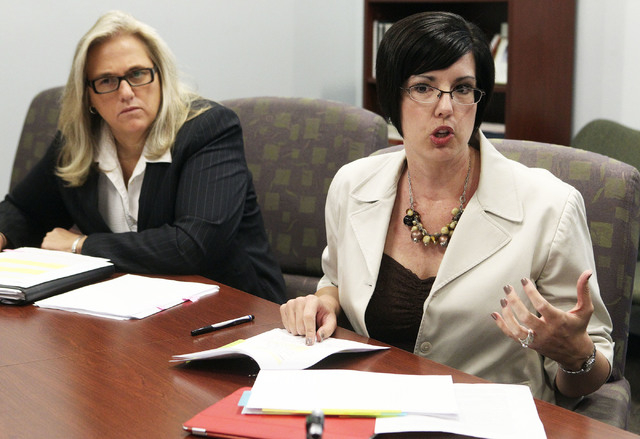County tackles growing child welfare caseloads
Large worker caseloads aren’t a new issue for Clark County’s child welfare agency.
In 2007, consultant Edward E. Cotton even suggested that the county’s Department of Family Services establish caseload sizes based on standards set by the Washington, D.C.-based Child Welfare League of America or other national groups, but that recommendation was never followed. Nevada doesn’t have a regulation that caps the number of cases that a social worker is assigned.
Establishing such a cap isn’t something Jeff Wells, assistant Clark County manager, would support, anyway.
“I’m supportive of getting more positions and reducing Child Protective Services investigations and keeping (foster care caseloads) down, but I’m not supportive of creating a fixed-number measurement and a subjective system,” Wells said this week.
However, almost half of Family Services’ employees have signed a petition calling for agency improvements that they claim are necessary because of large caseloads and allegations of unsafe conditions for workers and children. The Service Employees International Union, which represents eligible Family Services employees, on Tuesday presented the petition to Clark County commissioners and sought their support.
County management was already in conversations with employees about their concerns. Wells said county officials plan to tackle issues with Child Protective Services investigations first.
The average caseload for Child Protective Services is 18 investigations per worker, according to Family Services. The average caseload for permanency workers, who oversee children in foster care, is 13. That’s an average of 25 children per worker.
In 2007, a blue ribbon panel also recommended that the Nevada Division of Child and Family Services, which has state oversight of Family Services, apply best practices with consideration of local needs and the standards from the Child Welfare League of America.
The national organization recommends 12 cases per month per social worker for the initial investigation and 17 active cases per social worker for ongoing cases. For foster care, the organization recommends 12 to 15 children per social worker.
“Whenever actual caseloads exceed established standards by 10 percent for over six months, the funding must be increased to meet the caseload demands,” the 2007 recommendation reads.
ADDITIONAL STAFFING
A group of 32 to 35 Family Services employees are going through their 12-week academy training, which they will complete at the end of this month, Wells said. Those employees were hired to fill vacancies in the department of about 800 full-time employees.
The majority of those workers will be assigned to Child Protective Services investigations, he said. In early fall, officials will pair them with a more experienced worker before they are given their own caseloads.
Another 47 employees, who have yet to be hired, could start the 12-week academy training in September, Wells said. Those positions went into effect in July, but “if not zero, close to zero” people have been hired because recruitment just began last month, he said.
“I want to see what the effect (on Child Protective Services’ investigations) is of the first group that’s getting done with training at the end of August,” Wells said.
The number of Child Protective Services investigations has gone up in the last year, especially in recent months. County officials want to see if the spike is short-term or not, Wells said. If the increase becomes an ongoing problem, officials will dedicate the additional 47 positions to those investigations, as well, he said.
But not everyone thinks that adding positions will resolve the concerns raised by the service employees union.
“CPS needs to learn how to do a risk assessment before they start adding people,” said Donna Coleman, a longtime local child advocate.
County officials need to review all the cases because some may not be complicated “and probably should have been closed a long time ago,” she said. Or there might be cases that don’t require much work to close.
“I know there are cases where the only thing they (caseworkers) are supposed to do is getting a kid to the therapist,” she said. “I don’t know if the caseloads are really reflecting heavy legwork.”
OPTIONS AND ALTERNATIVES
Family Services officials are redistributing geographic zone coverage to create more balance in case assignments and rotations, Director Lisa Ruiz-Lee, said during a Thursday policy and fiscal affairs meeting for Family Services and the Clark County Department of Juvenile Justice Services.
The department could also use providers such as St. Jude’s Ranch for Children to manage some cases for the agency, Coleman said during a phone interview Wednesday.
Sibling groups are getting larger and larger, Ruiz-Lee said. The agency has recently started seeing sibling groups as large as 10 and 11.
“It’s been a very strange phenomenon,” she said during the meeting.
Officials will consider working with providers to help shelter large sibling groups, Ruiz-Lee said.
At the same meeting, Family Court Judge William Voy asked Ruiz-Lee if reducing the number of supervisors and managers to increase the number of caseworkers had been considered.
“Maybe it’s time to take a look at the structure and see if there’s a better way to do it,” Voy said.
Ruiz-Lee said there are only 12 managers in her department and they all carry a heavy load.
The caseworker qualifications are also an issue to Coleman, who favors hiring those with a background in social work.
“You might not have to hire so many people,” she said.
“I truly believe that they should have licensed social workers. At the minimum, supervisors should be licensed social workers.”
In 2011, county management with input from Family Services and Human Resources, made the decision to expand the kind of college degrees that would qualify a prospective employee for a job with the agency, according to county spokesman Erik Pappa.
Before the changes, to qualify for a Family Services specialist I position, people had to have a college degree in social work, criminal justice, psychology, social services, sociology or related field, according to Pappa.
After the changes, qualifications for the same position were expanded to include human or social services, education or special education, public or business administration, behavioral science, counseling, early childhood education, health science, child development, nursing, communications, marketing or a related field.
“Expanding the requirements gives us a better pool of candidates to select from for these very important positions,” according to Pappa. “Previously, we were barring excellent candidates from even applying.”
“It’s pretty concerning,” said J.B. Fripp, executive director of the National Association of Social Workers, Nevada Chapter, of the expansion of qualified college degrees. “At a minimum, the supervisors or managers and/or team leaders should be a licensed social worker.”




























